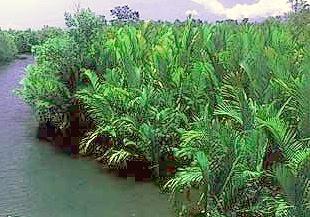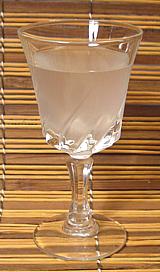Nipa Palm
 [Mangrove Palm;
Nipa (Philippines); Nipah (Indonesia, Malaysia); Dura Nuroc (Viet);
Gol Pata (Bangladesh); Dani (Burma); Attap Palm (Singapore);
Nypa fruticans]
[Mangrove Palm;
Nipa (Philippines); Nipah (Indonesia, Malaysia); Dura Nuroc (Viet);
Gol Pata (Bangladesh); Dani (Burma); Attap Palm (Singapore);
Nypa fruticans]
This Southeast Asian feather palm grows in tidal mangrove swamps where it
may constitute most of the vegetation. The trunk lies horizontal buried in
mud and only fronds and flower stalks grow upward out of the mud and
water. Sap from the inflorescence (flower clusters) can
be tapped just as in other palms and is made into an alcoholic beverage
called Tuba.
In the Philippines Tuba is given a secondary fermentation to turn it
into vinegar called Sukang Paombong.
Photo by Latorilla distributed under
GNU Free Documentation License v2.1 or later.
More on Palm Products.
 Sukang Paombong (Nipa Palm Vinegar) can be found in Philippine
markets in the US, which in turn, at least in Southern California, can
be found near any large hospital complex. Our health care system here
runs almost entirely on Filipino immigrants. In a taste test I preferred
this vinegar to the Philippine coconut palm vinegar I had on hand. Of
course quality varies - I use a premium brand, Lutong Pinoy "export
quality". Ingredients are: Fermented Nipa Palm Sap, Water, Cloudifier.
Apparently in the Philippines palm and coconut vinegar must be cloudy.
Sukang Paombong (Nipa Palm Vinegar) can be found in Philippine
markets in the US, which in turn, at least in Southern California, can
be found near any large hospital complex. Our health care system here
runs almost entirely on Filipino immigrants. In a taste test I preferred
this vinegar to the Philippine coconut palm vinegar I had on hand. Of
course quality varies - I use a premium brand, Lutong Pinoy "export
quality". Ingredients are: Fermented Nipa Palm Sap, Water, Cloudifier.
Apparently in the Philippines palm and coconut vinegar must be cloudy.
This vinegar can be used in the same sort of applications rice vinegar
is used for - and particularly for Philippine recipes (Filipinos are very
big on vinegared dishes).
pm_nipaz. 081017 - www.clovegarden.com
©Andrew Grygus - agryg@clovegaden.com - Photos on this
page not otherwise credited are © cg1 -
Linking to and non-commercial use of this page permitted
 Sukang Paombong (Nipa Palm Vinegar) can be found in Philippine
markets in the US, which in turn, at least in Southern California, can
be found near any large hospital complex. Our health care system here
runs almost entirely on Filipino immigrants. In a taste test I preferred
this vinegar to the Philippine coconut palm vinegar I had on hand. Of
course quality varies - I use a premium brand, Lutong Pinoy "export
quality". Ingredients are: Fermented Nipa Palm Sap, Water, Cloudifier.
Apparently in the Philippines palm and coconut vinegar must be cloudy.
Sukang Paombong (Nipa Palm Vinegar) can be found in Philippine
markets in the US, which in turn, at least in Southern California, can
be found near any large hospital complex. Our health care system here
runs almost entirely on Filipino immigrants. In a taste test I preferred
this vinegar to the Philippine coconut palm vinegar I had on hand. Of
course quality varies - I use a premium brand, Lutong Pinoy "export
quality". Ingredients are: Fermented Nipa Palm Sap, Water, Cloudifier.
Apparently in the Philippines palm and coconut vinegar must be cloudy.
 [Mangrove Palm;
Nipa (Philippines); Nipah (Indonesia, Malaysia); Dura Nuroc (Viet);
Gol Pata (Bangladesh); Dani (Burma); Attap Palm (Singapore);
Nypa fruticans]
[Mangrove Palm;
Nipa (Philippines); Nipah (Indonesia, Malaysia); Dura Nuroc (Viet);
Gol Pata (Bangladesh); Dani (Burma); Attap Palm (Singapore);
Nypa fruticans]